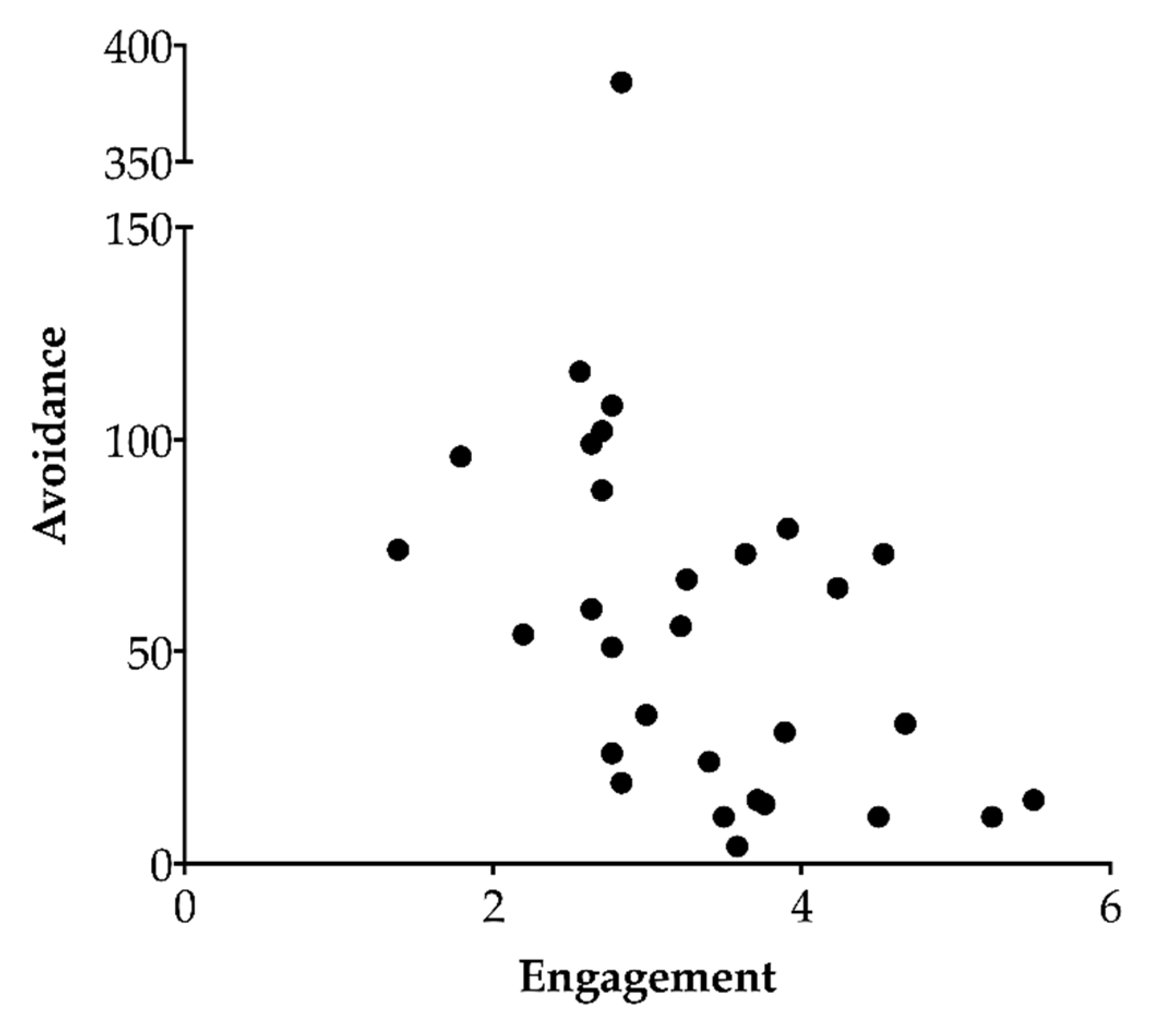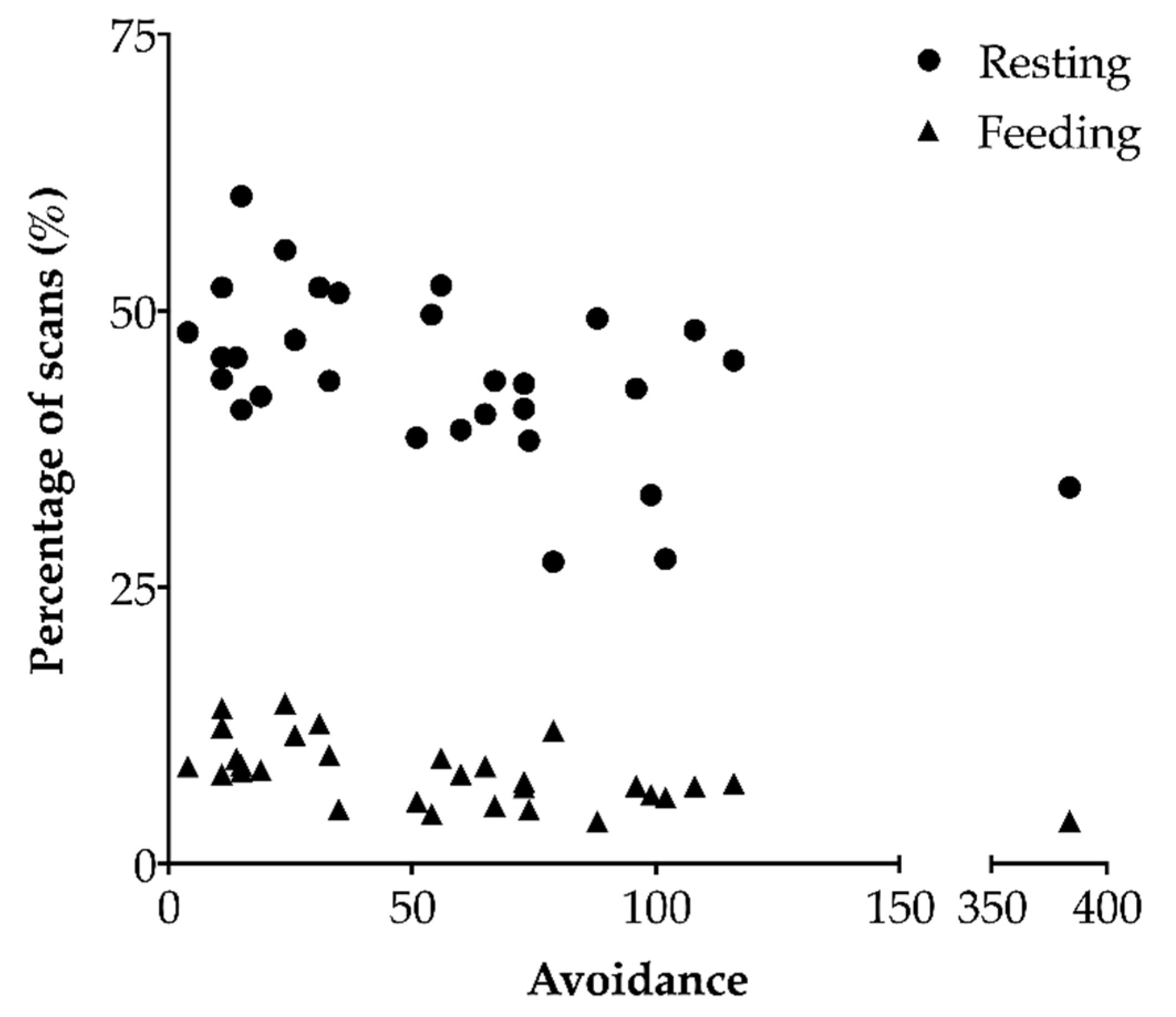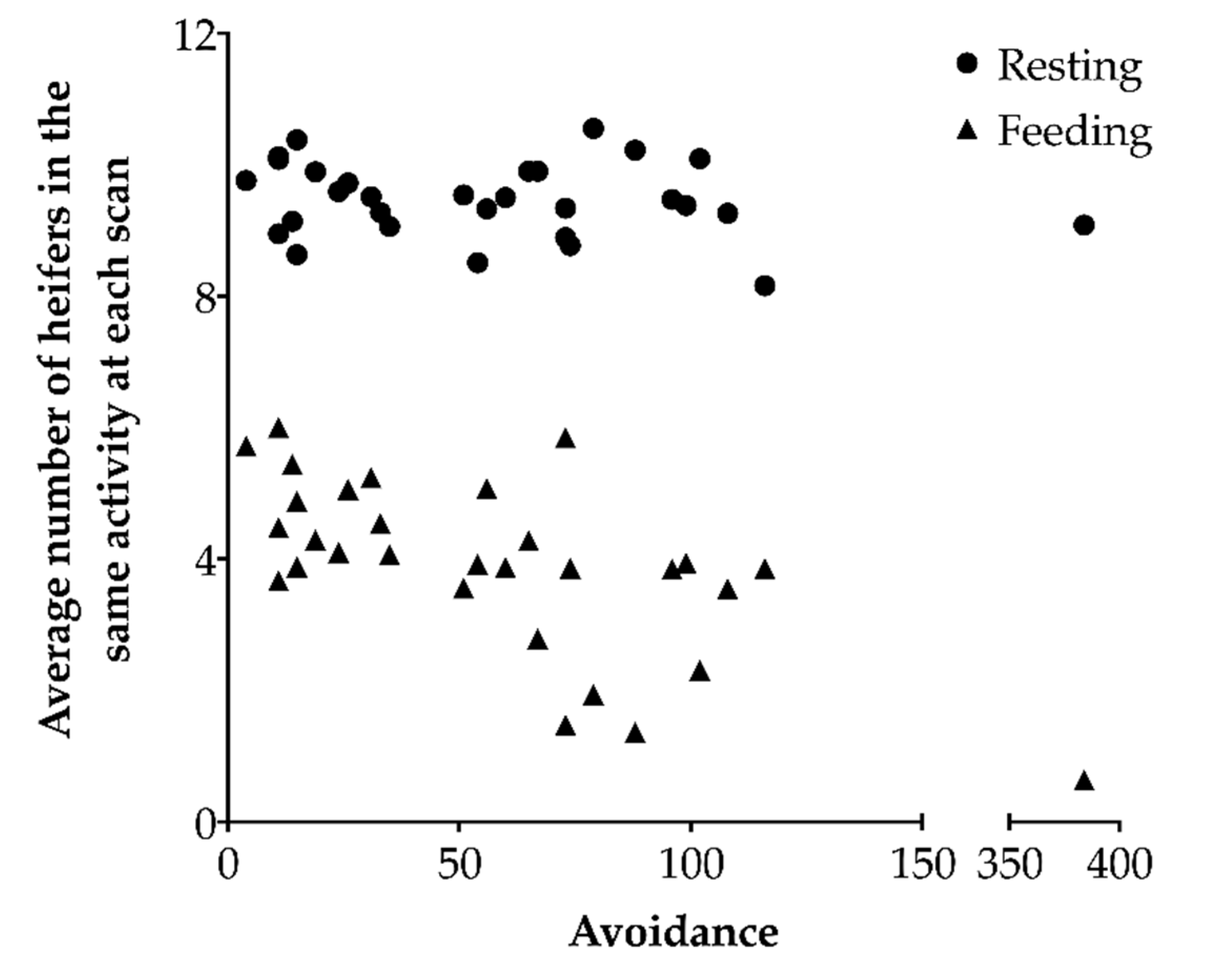Individual Variability in Response to Social Stress in Dairy Heifers
Simple Summary
Abstract
1. Introduction
2. Materials and Methods
3. Results
4. Discussion
5. Conclusions
Supplementary Materials
Author Contributions
Funding
Acknowledgments
Conflicts of Interest
References
- Boissy, A.; Le Neindre, P. Behavioral, cardiac and cortisol responses to brief peer separation and reunion in cattle. Physiol. Behav. 1997, 61, 693–699. [Google Scholar] [CrossRef]
- Holm, L.; Jensen, M.B.; Jeppesen, L.L. Calves’ motivation for access to two different types of social contact measured by operant conditioning. Appl. Anim. Behav. Sci. 2002, 79, 175–194. [Google Scholar] [CrossRef]
- Foris, B.; Zebunke, M.; Langbein, J.; Melzer, N. Comprehensive analysis of affiliative and agonistic social networks in lactating dairy cattle groups. Appl. Anim. Behav. Sci. 2019, 210, 60–67. [Google Scholar] [CrossRef]
- Kondo, S.; Hurnik, J.F. Stabilization of social hierarchy in dairy cows. Appl. Anim. Behav. Sci. 1990, 27, 287–297. [Google Scholar] [CrossRef]
- Bouissou, M.-F.; Andrieu, S. Établissement des relations préférentielles chez les bovins domestiques. Behaviour 1978, 64, 148–157. [Google Scholar] [CrossRef]
- Raussi, S.; Niskanen, S.; Siivonen, J.; Hänninen, L.; Hepola, H.; Jauhiainen, L.; Veissier, I. The formation of preferential relationships at early age in cattle. Behav. Process. 2010, 84, 726–731. [Google Scholar] [CrossRef]
- Napolitano, F.; Knierim, U.; Grass, F.; De Rosa, G. Positive indicators of cattle welfare and their applicability to on-farm protocols. Ital. J. Anim. Sci. 2009, 8, 355–365. [Google Scholar] [CrossRef]
- Proudfoot, K.L.; Weary, D.M.; von Keyserlingk, M.A.G. Linking the social environment to illness in farm animals. Appl. Anim. Behav. Sci. 2012, 138, 203–215. [Google Scholar] [CrossRef]
- Peden, R.S.E.; Turner, S.P.; Boyle, L.A.; Camerlink, I. The translation of animal welfare research into practice: The case of mixing aggression between pigs. Appl. Anim. Behav. Sci. 2018, 204, 1–9. [Google Scholar] [CrossRef]
- Beery, A.K.; Kaufer, D. Stress, social behavior, and resilience: Insights from rodents. Neurobiol. Stress 2015, 1, 116–127. [Google Scholar] [CrossRef]
- Bouissou, M.-F.; Lavenet, C.; Orgeur, P. Établissement des relations de dominance-soumission chez les bovins domestiques. I. Nature et évolution des interactions sociales. Ann. Biol. Anim. Biochim. Biophys. 1974, 14, 383–410. [Google Scholar] [CrossRef]
- Schirmann, K.; Chapinal, N.; Weary, D.M.; Heuwieser, W.; von Keyserlingk, M.A.G. Short-term effects of regrouping on behavior of prepartum dairy cows. J. Dairy Sci. 2011, 94, 2312–2319. [Google Scholar] [CrossRef] [PubMed]
- Val-Laillet, D.; de Passillé, A.M.; Rushen, J.; von Keyserlingk, M.A.G. The concept of social dominance and the social distribution of feeding-related displacements between cows. Appl. Anim. Behav. Sci. 2008, 111, 158–172. [Google Scholar] [CrossRef]
- Færevik, G.; Andersen, I.L.; Jensen, M.B.; Bøe, K.E. Increased group size reduces conflicts and strengthens the preference for familiar group mates after regrouping of weaned dairy calves (Bos taurus). Appl. Anim. Behav. Sci. 2007, 108, 215–228. [Google Scholar] [CrossRef]
- Estevez, I.; Andersen, I.-L.; Nævdal, E. Group size, density and social dynamics in farm animals. Appl. Anim. Behav. Sci. 2007, 103, 185–204. [Google Scholar] [CrossRef]
- Koolhaas, J.M.; Van Reenen, C.G. Individual differences in behavioral and physiological responsiveness of primiparous dairy cows to machine milking. J. Anim. Sci. 2016, 94, 2284–2296. [Google Scholar] [CrossRef]
- Van Reenen, C.G.; Van der Werf, J.T.N.; Bruckmaier, R.M.; Hopster, H.; Engel, B.; Noordhuizen, J.P.T.M.; Blokhuis, H.J. Individual Differences in Behavioral and Physiological Responsiveness of Primiparous Dairy Cows to Machine Milking. J. Dairy Sci. 2002, 85, 2551–2561. [Google Scholar] [CrossRef]
- Van Reenen, C.G.; O’Connell, N.E.; Van der Werf, J.T.N.; Korte, S.M.; Hopster, H.; Jones, R.B.; Blokhuis, H.J. Responses of calves to acute stress: Individual consistency and relations between behavioral and physiological measures. Physiol. Behav. 2005, 85, 557–570. [Google Scholar] [CrossRef]
- Lecorps, B.; Kappel, S.; Weary, D.M.; von Keyserlingk, M.A.G. Dairy calves’ personality traits predict social proximity and response to an emotional challenge. Sci. Rep. 2018, 8, 16350. [Google Scholar] [CrossRef]
- Val-Laillet, D.; Guesdon, V.; von Keyserlingk, M.A.G.; de Passillé, A.M.; Rushen, J. Allogrooming in cattle: Relationships between social preferences, feeding displacements and social dominance. Appl. Anim. Behav. Sci. 2009, 116, 141–149. [Google Scholar] [CrossRef]
- Foris, B.; von Keyserlingk, M.A.G.; Weary, D.M. Competition strategies of metritic and healthy transition cows. Animals 2020, 10, 854. [Google Scholar] [CrossRef]
- Mendl, M.; Deag, J.M. How useful are the concepts of alternative strategy and coping strategy in applied studies of social behaviour? Appl. Anim. Behav. Sci. 1995, 44, 119–137. [Google Scholar] [CrossRef]
- von Keyserlingk, M.A.G.; Olenick, D.; Weary, D.M. Acute behavioral effects of regrouping dairy cows. J. Dairy Sci. 2008, 91, 1011–1016. [Google Scholar] [CrossRef] [PubMed]
- Patt, A.; Gygax, L.; Wechsler, B.; Hillmann, E.; Palme, R.; Keil, N.M. The introduction of individual goats into small established groups has serious negative effects on the introduced goat but not on resident goats. Appl. Anim. Behav. Sci. 2012, 138, 47–59. [Google Scholar] [CrossRef]
- Merlot, E.; Meunier-Salaün, M.-C.; Prunier, A. Behavioural, endocrine and immune consequences of mixing in weaned piglets. Appl. Anim. Behav. Sci. 2004, 85, 247–257. [Google Scholar] [CrossRef]
- Neave, H.W.; Weary, D.M.; von Keyserlingk, M.A.G. Review: Individual variability in feeding behaviour of domesticated ruminants. Animal 2018, 12, s419–s430. [Google Scholar] [CrossRef] [PubMed]
- Zobel, G.; Schwartzkopf-Genswein, K.S.; Genswein, B.M.A.; von Keyserlingk, M.A.G. Impact of agonistic interactions on feeding behaviours when beef heifers are fed in a competitive feeding environment. Livest. Sci. 2011, 137, 1–9. [Google Scholar] [CrossRef]
- Gibbons, J.M.; Lawrence, A.B.; Haskell, M.J. Consistency of aggressive feeding behaviour in dairy cows. Appl. Anim. Behav. Sci. 2009, 121, 1–7. [Google Scholar] [CrossRef]
- Proudfoot, K.L.; Veira, D.M.; Weary, D.M.; von Keyserlingk, M.A.G. Competition at the feed bunk changes the feeding, standing, and social behavior of transition dairy cows. J. Dairy Sci. 2009, 92, 3116–3123. [Google Scholar] [CrossRef]
- Smid, A.-M.C.; Weary, D.M.; Bokkers, E.A.M.; von Keyserlingk, M.A.G. Short communication: The effects of regrouping in relation to fresh feed delivery in lactating Holstein cows. J. Dairy Sci. 2019, 102, 6545–6550. [Google Scholar] [CrossRef]
- Proudfoot, K.L.; Weary, D.M.; LeBlanc, S.J.; Mamedova, L.K.; von Keyserlingk, M.A.G. Exposure to an unpredictable and competitive social environment affects behavior and health of transition dairy cows. J. Dairy Sci. 2018, 101, 9309–9320. [Google Scholar] [CrossRef]
- McGlone, J.J. Influence of resources on pig aggression and dominance. Behav. Process. 1986, 12, 135–144. [Google Scholar] [CrossRef]
- Koolhaas, J.M.; Korte, S.M.; De Boer, S.F.; Van Der Vegt, B.J.; Van Reenen, C.G.; Hopster, H.; De Jong, I.C.; Ruis, M.A.W.; Blokhuis, H.J. Coping styles in animals: Current status in behavior and stress-physiology. Neurosci. Biobehav. Rev. 1999, 23, 925–935. [Google Scholar] [CrossRef]
- Verbeek, M.E.M.; Drent, P.; Goede, P.D.; Wiepkema, P. Individual behavioural characteristics and dominance in aviary groups of great tits. Behaviour 1999, 136, 23–48. [Google Scholar] [CrossRef]
- Bolhuis, J.E.; Schouten, W.G.P.; Schrama, J.W.; Wiegant, V.M. Individual coping characteristics, aggressiveness and fighting strategies in pigs. Anim. Behav. 2005, 69, 1085–1091. [Google Scholar] [CrossRef]
- Turner, S.P.; Nevison, I.M.; Desire, S.; Camerlink, I.; Roehe, R.; Ison, S.H.; Farish, M.; Jack, M.C.; D’Eath, R.B. Aggressive behaviour at regrouping is a poor predictor of chronic aggression in stable social groups. Appl. Anim. Behav. Sci. 2017, 191, 98–106. [Google Scholar] [CrossRef]
- Gibbons, J.M.; Lawrence, A.B.; Haskell, M.J. Measuring sociability in dairy cows. Appl. Anim. Behav. Sci. 2010, 122, 84–91. [Google Scholar] [CrossRef]
- Lecorps, B.; Kappel, S.; Weary, D.M.; von Keyserlingk, M.A.G. Social proximity in dairy calves is affected by differences in pessimism. PLoS ONE 2019, 14, e0223746. [Google Scholar] [CrossRef]
- Schein, M.W.; Fohrman, M.H. Social dominance relationships in a herd of dairy cattle. Br. J. Anim. Behav. 1955, 3, 45–55. [Google Scholar] [CrossRef]
- Hasegawa, N.; Nishiwaki, A.; Sugawara, K.; Ito, I. The effects of social exchange between two groups of lactating primiparous heifers on milk production, dominance order, behavior and adrenocortical response. Appl. Anim. Behav. Sci. 1997, 51, 15–27. [Google Scholar] [CrossRef]
- Wagner, K.; Barth, K.; Palme, R.; Futschik, A.; Waiblinger, S. Integration into the dairy cow herd: Long-term effects of mother contact during the first twelve weeks of life. Appl. Anim. Behav. Sci. 2012, 141, 117–129. [Google Scholar] [CrossRef]
- DeVries, T.J.; von Keyserlingk, M.A.G.; Weary, D.M. Effect of feeding space on the inter-cow distance, aggression, and feeding behavior of free-stall housed lactating dairy cows. J. Dairy Sci. 2004, 87, 1432–1438. [Google Scholar] [CrossRef]
- Wierenga, H.K. Social dominance in dairy cattle and the influences of housing and management. Appl. Anim. Behav. Sci. 1990, 27, 201–229. [Google Scholar] [CrossRef]




© 2020 by the authors. Licensee MDPI, Basel, Switzerland. This article is an open access article distributed under the terms and conditions of the Creative Commons Attribution (CC BY) license (http://creativecommons.org/licenses/by/4.0/).
Share and Cite
Nogues, E.; Lecorps, B.; Weary, D.M.; von Keyserlingk, M.A.G. Individual Variability in Response to Social Stress in Dairy Heifers. Animals 2020, 10, 1440. https://doi.org/10.3390/ani10081440
Nogues E, Lecorps B, Weary DM, von Keyserlingk MAG. Individual Variability in Response to Social Stress in Dairy Heifers. Animals. 2020; 10(8):1440. https://doi.org/10.3390/ani10081440
Chicago/Turabian StyleNogues, Emeline, Benjamin Lecorps, Daniel M. Weary, and Marina A. G. von Keyserlingk. 2020. "Individual Variability in Response to Social Stress in Dairy Heifers" Animals 10, no. 8: 1440. https://doi.org/10.3390/ani10081440
APA StyleNogues, E., Lecorps, B., Weary, D. M., & von Keyserlingk, M. A. G. (2020). Individual Variability in Response to Social Stress in Dairy Heifers. Animals, 10(8), 1440. https://doi.org/10.3390/ani10081440





